Critical Literature Analysis: Technology Integration in Education
VerifiedAdded on 2022/11/03
|11
|3191
|446
Report
AI Summary
This report provides a critical literature analysis of four research papers related to educational technology. The first paper, by Howard et al. (2017), examines a system model of technology integration to inform learning task design, discussing the complexities of integrating digital technologies in teaching and learning, and utilizing teacher models and EDM. Almas and Krumsvik (2008) focus on the gap between teachers' intentions and ICT practices in technology-rich classrooms, analyzing data from interviews, observations, and document analysis within a Norwegian school system. Haugsbakk and Nordkvelle (2007) analyze the rhetoric of ICT and the new language of learning, connecting it with Biesta's concept of learning as a consumer-provider exchange. Finally, Biesta (2005) critiques the 'new language of learning', arguing for a return to a language that understands educational relationships, exploring the impact of this language on the roles of teachers and learners. Each paper's analysis includes a summary of the context, methods, and paradigm, as well as answering specific questions related to each paper. The analysis highlights the key arguments, methodologies, and the underlying philosophical paradigms of each study, providing a comprehensive overview of the selected literature.
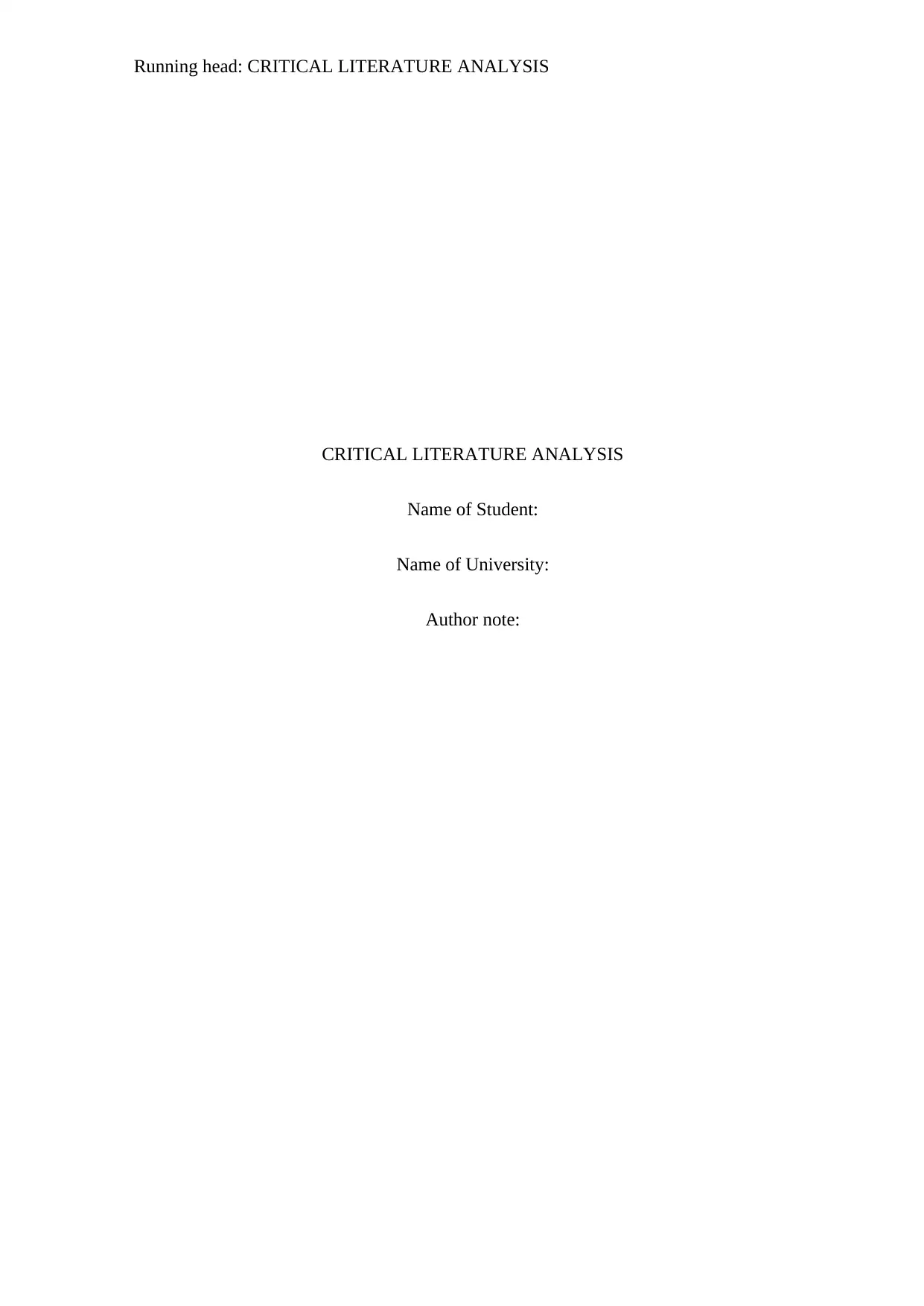
Running head: CRITICAL LITERATURE ANALYSIS
CRITICAL LITERATURE ANALYSIS
Name of Student:
Name of University:
Author note:
CRITICAL LITERATURE ANALYSIS
Name of Student:
Name of University:
Author note:
Paraphrase This Document
Need a fresh take? Get an instant paraphrase of this document with our AI Paraphraser
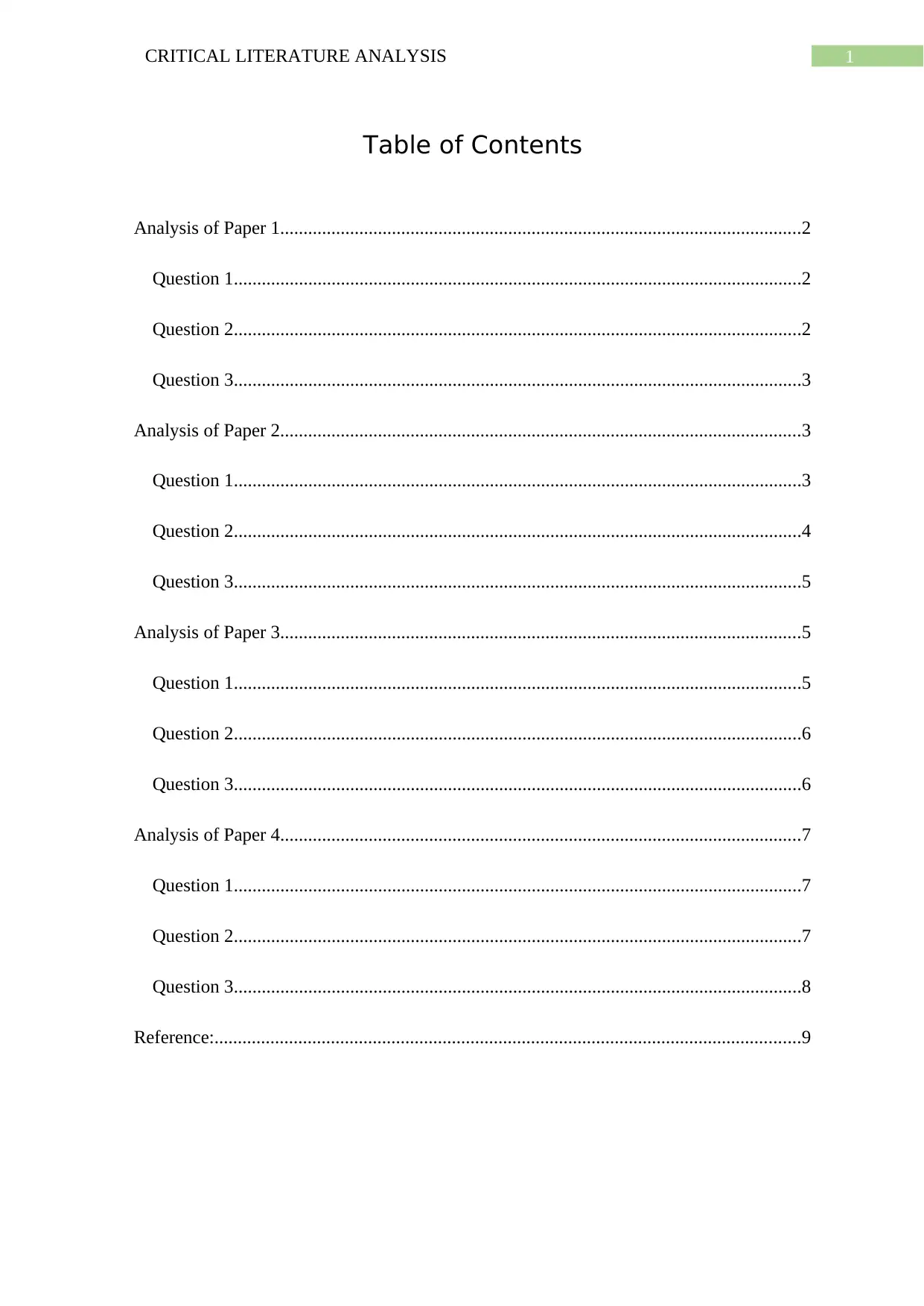
1CRITICAL LITERATURE ANALYSIS
Table of Contents
Analysis of Paper 1................................................................................................................2
Question 1..........................................................................................................................2
Question 2..........................................................................................................................2
Question 3..........................................................................................................................3
Analysis of Paper 2................................................................................................................3
Question 1..........................................................................................................................3
Question 2..........................................................................................................................4
Question 3..........................................................................................................................5
Analysis of Paper 3................................................................................................................5
Question 1..........................................................................................................................5
Question 2..........................................................................................................................6
Question 3..........................................................................................................................6
Analysis of Paper 4................................................................................................................7
Question 1..........................................................................................................................7
Question 2..........................................................................................................................7
Question 3..........................................................................................................................8
Reference:..............................................................................................................................9
Table of Contents
Analysis of Paper 1................................................................................................................2
Question 1..........................................................................................................................2
Question 2..........................................................................................................................2
Question 3..........................................................................................................................3
Analysis of Paper 2................................................................................................................3
Question 1..........................................................................................................................3
Question 2..........................................................................................................................4
Question 3..........................................................................................................................5
Analysis of Paper 3................................................................................................................5
Question 1..........................................................................................................................5
Question 2..........................................................................................................................6
Question 3..........................................................................................................................6
Analysis of Paper 4................................................................................................................7
Question 1..........................................................................................................................7
Question 2..........................................................................................................................7
Question 3..........................................................................................................................8
Reference:..............................................................................................................................9
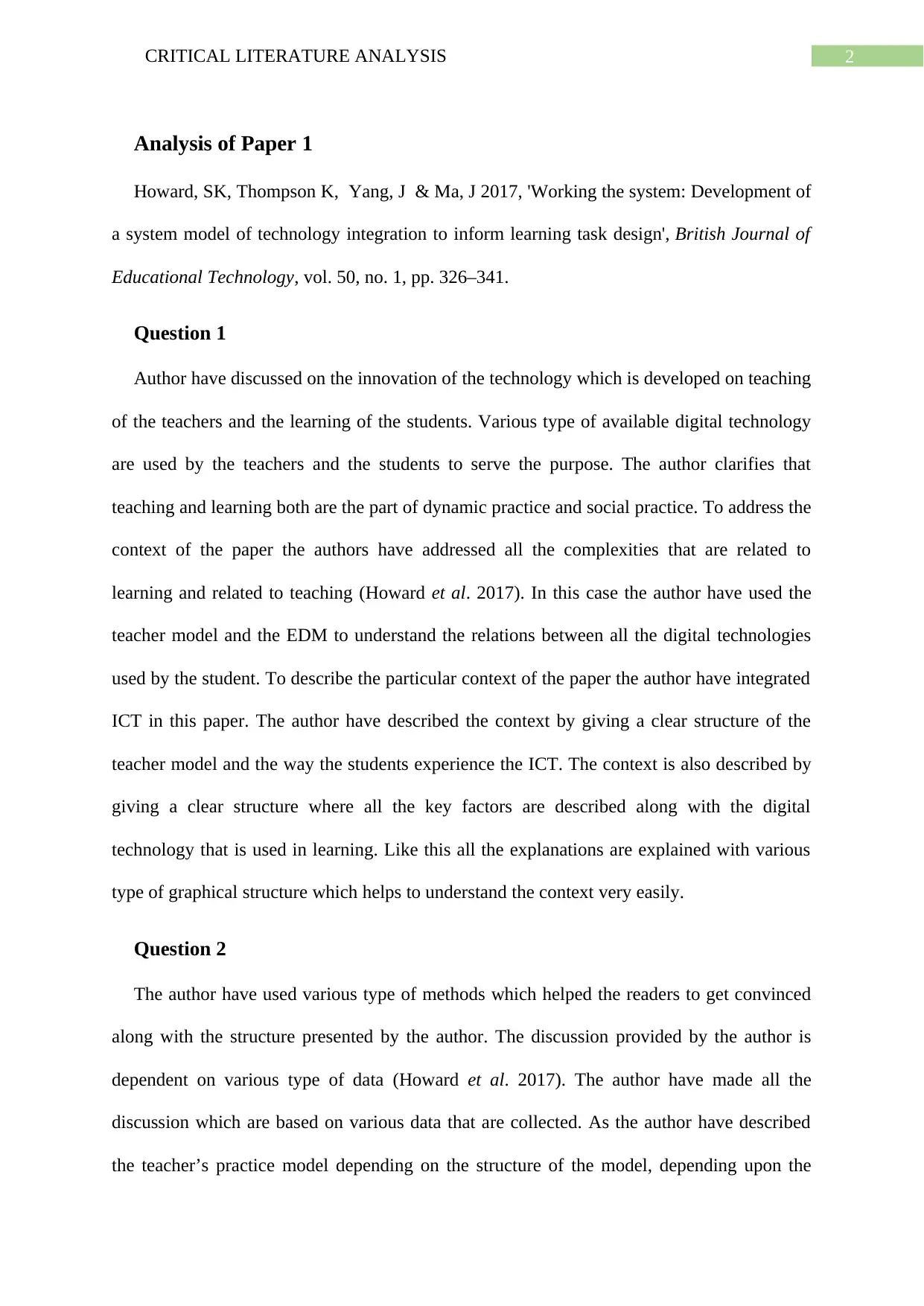
2CRITICAL LITERATURE ANALYSIS
Analysis of Paper 1
Howard, SK, Thompson K, Yang, J & Ma, J 2017, 'Working the system: Development of
a system model of technology integration to inform learning task design', British Journal of
Educational Technology, vol. 50, no. 1, pp. 326–341.
Question 1
Author have discussed on the innovation of the technology which is developed on teaching
of the teachers and the learning of the students. Various type of available digital technology
are used by the teachers and the students to serve the purpose. The author clarifies that
teaching and learning both are the part of dynamic practice and social practice. To address the
context of the paper the authors have addressed all the complexities that are related to
learning and related to teaching (Howard et al. 2017). In this case the author have used the
teacher model and the EDM to understand the relations between all the digital technologies
used by the student. To describe the particular context of the paper the author have integrated
ICT in this paper. The author have described the context by giving a clear structure of the
teacher model and the way the students experience the ICT. The context is also described by
giving a clear structure where all the key factors are described along with the digital
technology that is used in learning. Like this all the explanations are explained with various
type of graphical structure which helps to understand the context very easily.
Question 2
The author have used various type of methods which helped the readers to get convinced
along with the structure presented by the author. The discussion provided by the author is
dependent on various type of data (Howard et al. 2017). The author have made all the
discussion which are based on various data that are collected. As the author have described
the teacher’s practice model depending on the structure of the model, depending upon the
Analysis of Paper 1
Howard, SK, Thompson K, Yang, J & Ma, J 2017, 'Working the system: Development of
a system model of technology integration to inform learning task design', British Journal of
Educational Technology, vol. 50, no. 1, pp. 326–341.
Question 1
Author have discussed on the innovation of the technology which is developed on teaching
of the teachers and the learning of the students. Various type of available digital technology
are used by the teachers and the students to serve the purpose. The author clarifies that
teaching and learning both are the part of dynamic practice and social practice. To address the
context of the paper the authors have addressed all the complexities that are related to
learning and related to teaching (Howard et al. 2017). In this case the author have used the
teacher model and the EDM to understand the relations between all the digital technologies
used by the student. To describe the particular context of the paper the author have integrated
ICT in this paper. The author have described the context by giving a clear structure of the
teacher model and the way the students experience the ICT. The context is also described by
giving a clear structure where all the key factors are described along with the digital
technology that is used in learning. Like this all the explanations are explained with various
type of graphical structure which helps to understand the context very easily.
Question 2
The author have used various type of methods which helped the readers to get convinced
along with the structure presented by the author. The discussion provided by the author is
dependent on various type of data (Howard et al. 2017). The author have made all the
discussion which are based on various data that are collected. As the author have described
the teacher’s practice model depending on the structure of the model, depending upon the
⊘ This is a preview!⊘
Do you want full access?
Subscribe today to unlock all pages.

Trusted by 1+ million students worldwide
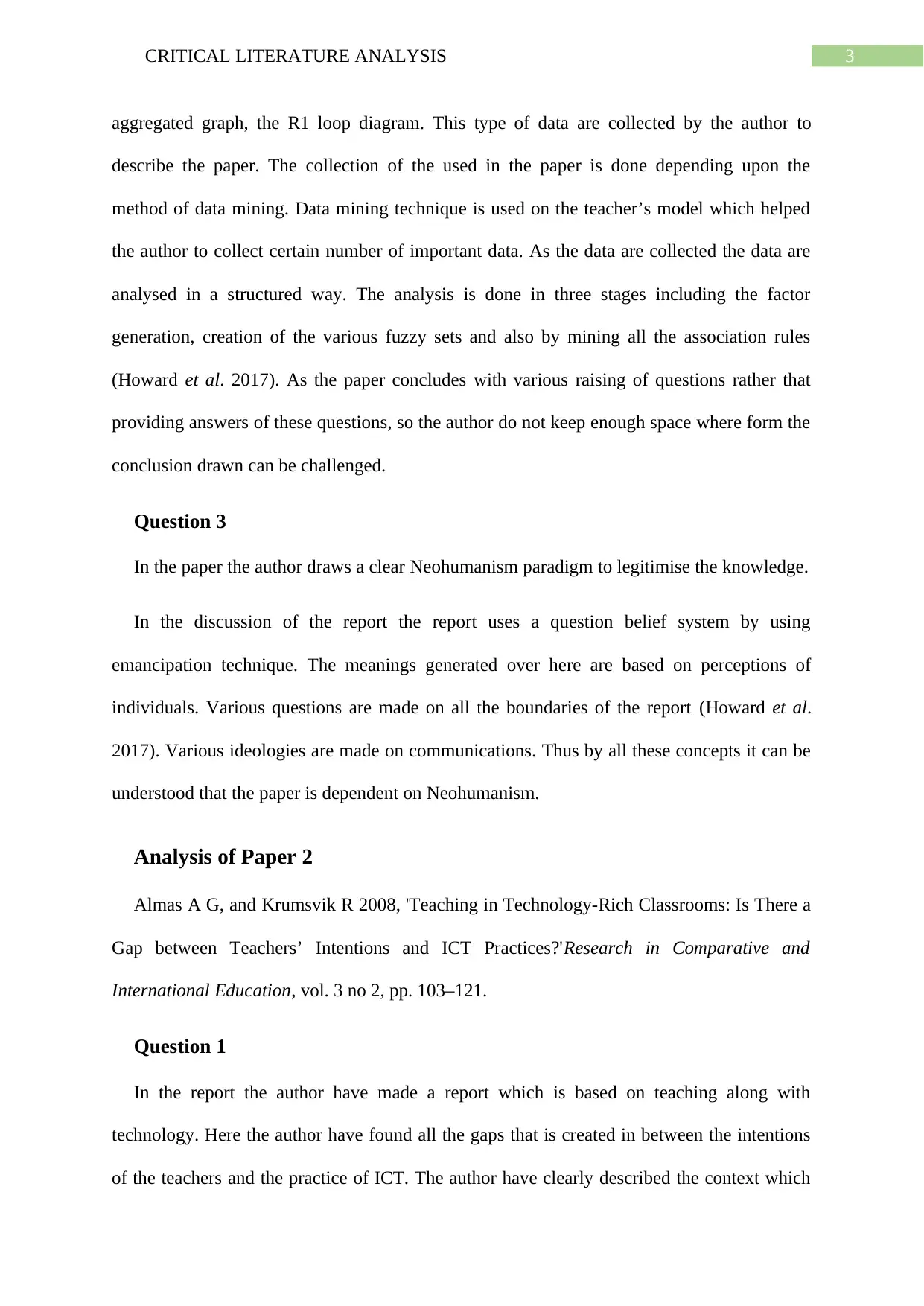
3CRITICAL LITERATURE ANALYSIS
aggregated graph, the R1 loop diagram. This type of data are collected by the author to
describe the paper. The collection of the used in the paper is done depending upon the
method of data mining. Data mining technique is used on the teacher’s model which helped
the author to collect certain number of important data. As the data are collected the data are
analysed in a structured way. The analysis is done in three stages including the factor
generation, creation of the various fuzzy sets and also by mining all the association rules
(Howard et al. 2017). As the paper concludes with various raising of questions rather that
providing answers of these questions, so the author do not keep enough space where form the
conclusion drawn can be challenged.
Question 3
In the paper the author draws a clear Neohumanism paradigm to legitimise the knowledge.
In the discussion of the report the report uses a question belief system by using
emancipation technique. The meanings generated over here are based on perceptions of
individuals. Various questions are made on all the boundaries of the report (Howard et al.
2017). Various ideologies are made on communications. Thus by all these concepts it can be
understood that the paper is dependent on Neohumanism.
Analysis of Paper 2
Almas A G, and Krumsvik R 2008, 'Teaching in Technology-Rich Classrooms: Is There a
Gap between Teachers’ Intentions and ICT Practices?'Research in Comparative and
International Education, vol. 3 no 2, pp. 103–121.
Question 1
In the report the author have made a report which is based on teaching along with
technology. Here the author have found all the gaps that is created in between the intentions
of the teachers and the practice of ICT. The author have clearly described the context which
aggregated graph, the R1 loop diagram. This type of data are collected by the author to
describe the paper. The collection of the used in the paper is done depending upon the
method of data mining. Data mining technique is used on the teacher’s model which helped
the author to collect certain number of important data. As the data are collected the data are
analysed in a structured way. The analysis is done in three stages including the factor
generation, creation of the various fuzzy sets and also by mining all the association rules
(Howard et al. 2017). As the paper concludes with various raising of questions rather that
providing answers of these questions, so the author do not keep enough space where form the
conclusion drawn can be challenged.
Question 3
In the paper the author draws a clear Neohumanism paradigm to legitimise the knowledge.
In the discussion of the report the report uses a question belief system by using
emancipation technique. The meanings generated over here are based on perceptions of
individuals. Various questions are made on all the boundaries of the report (Howard et al.
2017). Various ideologies are made on communications. Thus by all these concepts it can be
understood that the paper is dependent on Neohumanism.
Analysis of Paper 2
Almas A G, and Krumsvik R 2008, 'Teaching in Technology-Rich Classrooms: Is There a
Gap between Teachers’ Intentions and ICT Practices?'Research in Comparative and
International Education, vol. 3 no 2, pp. 103–121.
Question 1
In the report the author have made a report which is based on teaching along with
technology. Here the author have found all the gaps that is created in between the intentions
of the teachers and the practice of ICT. The author have clearly described the context which
Paraphrase This Document
Need a fresh take? Get an instant paraphrase of this document with our AI Paraphraser
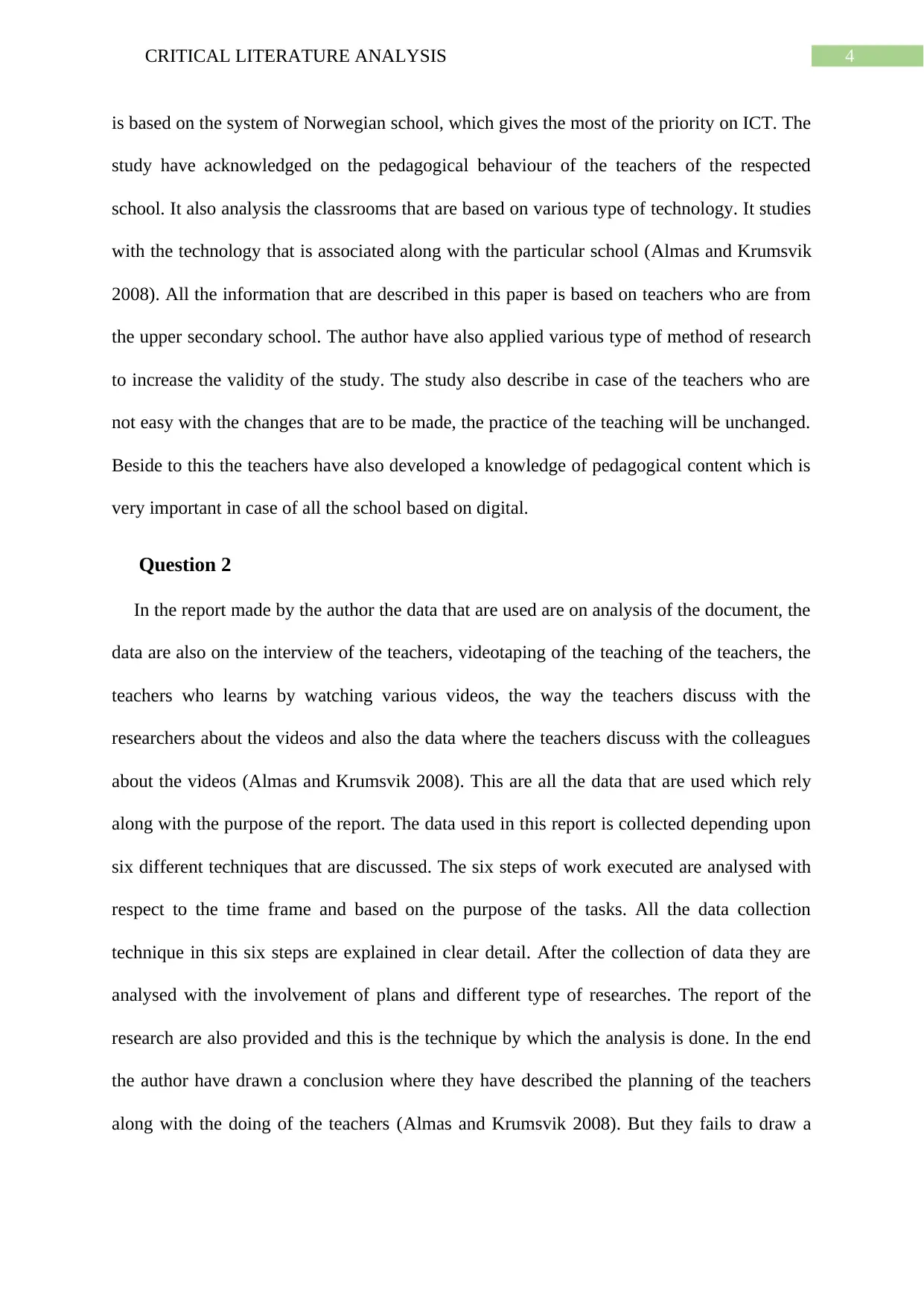
4CRITICAL LITERATURE ANALYSIS
is based on the system of Norwegian school, which gives the most of the priority on ICT. The
study have acknowledged on the pedagogical behaviour of the teachers of the respected
school. It also analysis the classrooms that are based on various type of technology. It studies
with the technology that is associated along with the particular school (Almas and Krumsvik
2008). All the information that are described in this paper is based on teachers who are from
the upper secondary school. The author have also applied various type of method of research
to increase the validity of the study. The study also describe in case of the teachers who are
not easy with the changes that are to be made, the practice of the teaching will be unchanged.
Beside to this the teachers have also developed a knowledge of pedagogical content which is
very important in case of all the school based on digital.
Question 2
In the report made by the author the data that are used are on analysis of the document, the
data are also on the interview of the teachers, videotaping of the teaching of the teachers, the
teachers who learns by watching various videos, the way the teachers discuss with the
researchers about the videos and also the data where the teachers discuss with the colleagues
about the videos (Almas and Krumsvik 2008). This are all the data that are used which rely
along with the purpose of the report. The data used in this report is collected depending upon
six different techniques that are discussed. The six steps of work executed are analysed with
respect to the time frame and based on the purpose of the tasks. All the data collection
technique in this six steps are explained in clear detail. After the collection of data they are
analysed with the involvement of plans and different type of researches. The report of the
research are also provided and this is the technique by which the analysis is done. In the end
the author have drawn a conclusion where they have described the planning of the teachers
along with the doing of the teachers (Almas and Krumsvik 2008). But they fails to draw a
is based on the system of Norwegian school, which gives the most of the priority on ICT. The
study have acknowledged on the pedagogical behaviour of the teachers of the respected
school. It also analysis the classrooms that are based on various type of technology. It studies
with the technology that is associated along with the particular school (Almas and Krumsvik
2008). All the information that are described in this paper is based on teachers who are from
the upper secondary school. The author have also applied various type of method of research
to increase the validity of the study. The study also describe in case of the teachers who are
not easy with the changes that are to be made, the practice of the teaching will be unchanged.
Beside to this the teachers have also developed a knowledge of pedagogical content which is
very important in case of all the school based on digital.
Question 2
In the report made by the author the data that are used are on analysis of the document, the
data are also on the interview of the teachers, videotaping of the teaching of the teachers, the
teachers who learns by watching various videos, the way the teachers discuss with the
researchers about the videos and also the data where the teachers discuss with the colleagues
about the videos (Almas and Krumsvik 2008). This are all the data that are used which rely
along with the purpose of the report. The data used in this report is collected depending upon
six different techniques that are discussed. The six steps of work executed are analysed with
respect to the time frame and based on the purpose of the tasks. All the data collection
technique in this six steps are explained in clear detail. After the collection of data they are
analysed with the involvement of plans and different type of researches. The report of the
research are also provided and this is the technique by which the analysis is done. In the end
the author have drawn a conclusion where they have described the planning of the teachers
along with the doing of the teachers (Almas and Krumsvik 2008). But they fails to draw a

5CRITICAL LITERATURE ANALYSIS
difference between the planning of the teachers and the doing of the teachers. This is the
reason there remains a gap in the conclusion which can be challenged further.
Question 3
In the paper the author draws a clear Social Relativism paradigm to legitimise the
knowledge.
In this report the author uses numerous number of realities along with interviews of the
individuals (Almas and Krumsvik 2008). The perspective of the individuals are also shown
along with the interpretation. The truth is also discovered in the paper which is based on the
experience. Fishbowl technique is also followed along with the desired ordered. Thus it can
be said that the article is based on social relativism.
Analysis of Paper 3
Haugsbakk, G & Nordkvelle Y 2007, 'The Rhetoric of ICT and the New Language of
Learning: A Critical Analysis of the Use of ICT in the Curricular Field', European
Educational Research Journal, vol. 6, no. 1, pp. 1–12.
Question 1
In the paper the author have drawn a rhetoric of the ICT and beside to this a language of
learning is also provided with the help of a critical analysis that is done on the use of ICT in
this particular field. The author have mainly focused on the way new technology can be
perceived along with the development of the technology in the field of education. The author
have also developed a link among the rhetoric ICT with the Biesta that is also known as the
new language for learning. In the new language which is described by the author, he
described learner to be the consumer and the need of the consumer is fulfilled by the teacher
(Haugsbakk and Nordkvelle 2007). The Biesta is also applied in the article where a scrutiny
is done on the recent trend of education and the way to implement ICT in the industry. The
difference between the planning of the teachers and the doing of the teachers. This is the
reason there remains a gap in the conclusion which can be challenged further.
Question 3
In the paper the author draws a clear Social Relativism paradigm to legitimise the
knowledge.
In this report the author uses numerous number of realities along with interviews of the
individuals (Almas and Krumsvik 2008). The perspective of the individuals are also shown
along with the interpretation. The truth is also discovered in the paper which is based on the
experience. Fishbowl technique is also followed along with the desired ordered. Thus it can
be said that the article is based on social relativism.
Analysis of Paper 3
Haugsbakk, G & Nordkvelle Y 2007, 'The Rhetoric of ICT and the New Language of
Learning: A Critical Analysis of the Use of ICT in the Curricular Field', European
Educational Research Journal, vol. 6, no. 1, pp. 1–12.
Question 1
In the paper the author have drawn a rhetoric of the ICT and beside to this a language of
learning is also provided with the help of a critical analysis that is done on the use of ICT in
this particular field. The author have mainly focused on the way new technology can be
perceived along with the development of the technology in the field of education. The author
have also developed a link among the rhetoric ICT with the Biesta that is also known as the
new language for learning. In the new language which is described by the author, he
described learner to be the consumer and the need of the consumer is fulfilled by the teacher
(Haugsbakk and Nordkvelle 2007). The Biesta is also applied in the article where a scrutiny
is done on the recent trend of education and the way to implement ICT in the industry. The
⊘ This is a preview!⊘
Do you want full access?
Subscribe today to unlock all pages.

Trusted by 1+ million students worldwide
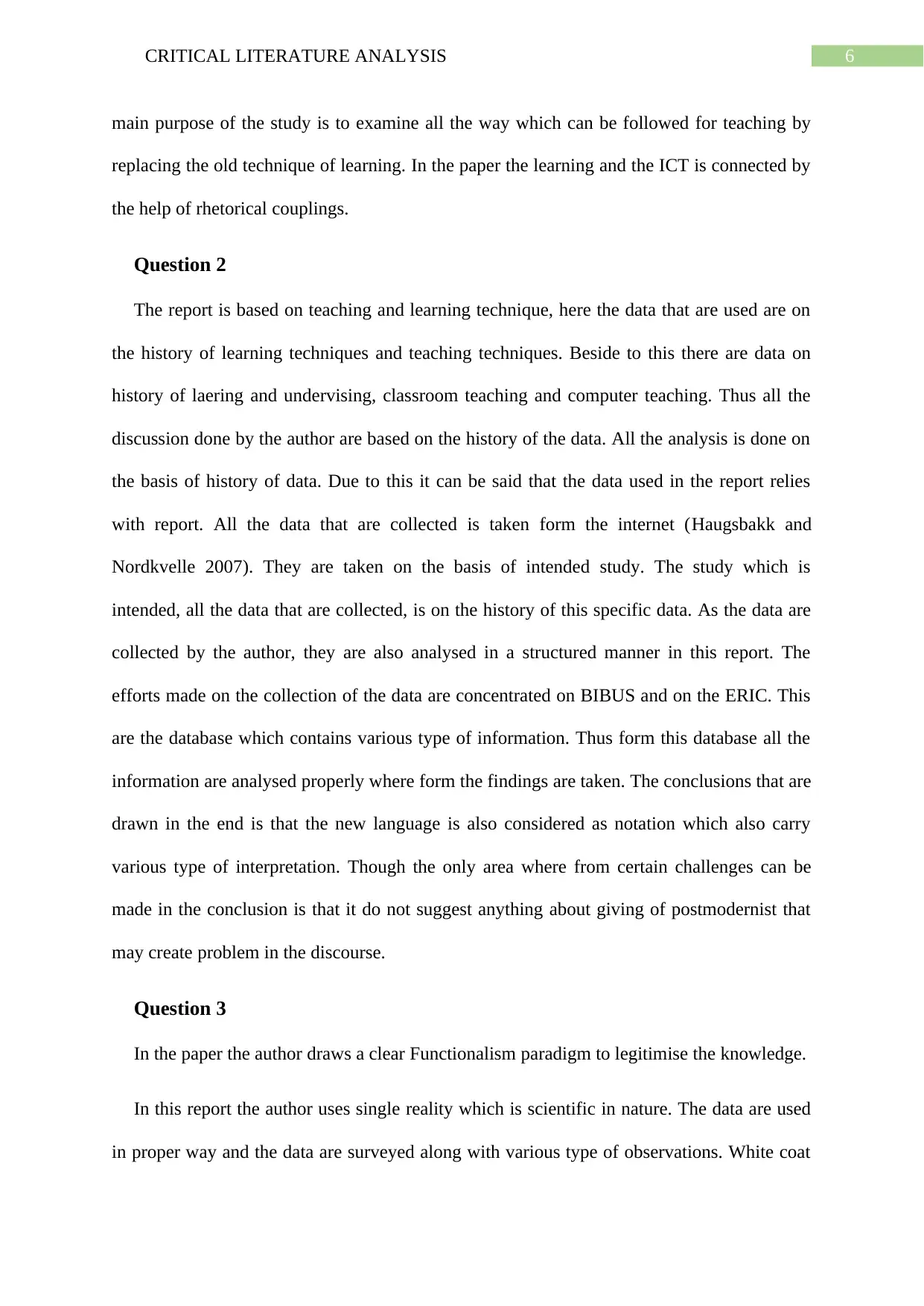
6CRITICAL LITERATURE ANALYSIS
main purpose of the study is to examine all the way which can be followed for teaching by
replacing the old technique of learning. In the paper the learning and the ICT is connected by
the help of rhetorical couplings.
Question 2
The report is based on teaching and learning technique, here the data that are used are on
the history of learning techniques and teaching techniques. Beside to this there are data on
history of laering and undervising, classroom teaching and computer teaching. Thus all the
discussion done by the author are based on the history of the data. All the analysis is done on
the basis of history of data. Due to this it can be said that the data used in the report relies
with report. All the data that are collected is taken form the internet (Haugsbakk and
Nordkvelle 2007). They are taken on the basis of intended study. The study which is
intended, all the data that are collected, is on the history of this specific data. As the data are
collected by the author, they are also analysed in a structured manner in this report. The
efforts made on the collection of the data are concentrated on BIBUS and on the ERIC. This
are the database which contains various type of information. Thus form this database all the
information are analysed properly where form the findings are taken. The conclusions that are
drawn in the end is that the new language is also considered as notation which also carry
various type of interpretation. Though the only area where from certain challenges can be
made in the conclusion is that it do not suggest anything about giving of postmodernist that
may create problem in the discourse.
Question 3
In the paper the author draws a clear Functionalism paradigm to legitimise the knowledge.
In this report the author uses single reality which is scientific in nature. The data are used
in proper way and the data are surveyed along with various type of observations. White coat
main purpose of the study is to examine all the way which can be followed for teaching by
replacing the old technique of learning. In the paper the learning and the ICT is connected by
the help of rhetorical couplings.
Question 2
The report is based on teaching and learning technique, here the data that are used are on
the history of learning techniques and teaching techniques. Beside to this there are data on
history of laering and undervising, classroom teaching and computer teaching. Thus all the
discussion done by the author are based on the history of the data. All the analysis is done on
the basis of history of data. Due to this it can be said that the data used in the report relies
with report. All the data that are collected is taken form the internet (Haugsbakk and
Nordkvelle 2007). They are taken on the basis of intended study. The study which is
intended, all the data that are collected, is on the history of this specific data. As the data are
collected by the author, they are also analysed in a structured manner in this report. The
efforts made on the collection of the data are concentrated on BIBUS and on the ERIC. This
are the database which contains various type of information. Thus form this database all the
information are analysed properly where form the findings are taken. The conclusions that are
drawn in the end is that the new language is also considered as notation which also carry
various type of interpretation. Though the only area where from certain challenges can be
made in the conclusion is that it do not suggest anything about giving of postmodernist that
may create problem in the discourse.
Question 3
In the paper the author draws a clear Functionalism paradigm to legitimise the knowledge.
In this report the author uses single reality which is scientific in nature. The data are used
in proper way and the data are surveyed along with various type of observations. White coat
Paraphrase This Document
Need a fresh take? Get an instant paraphrase of this document with our AI Paraphraser
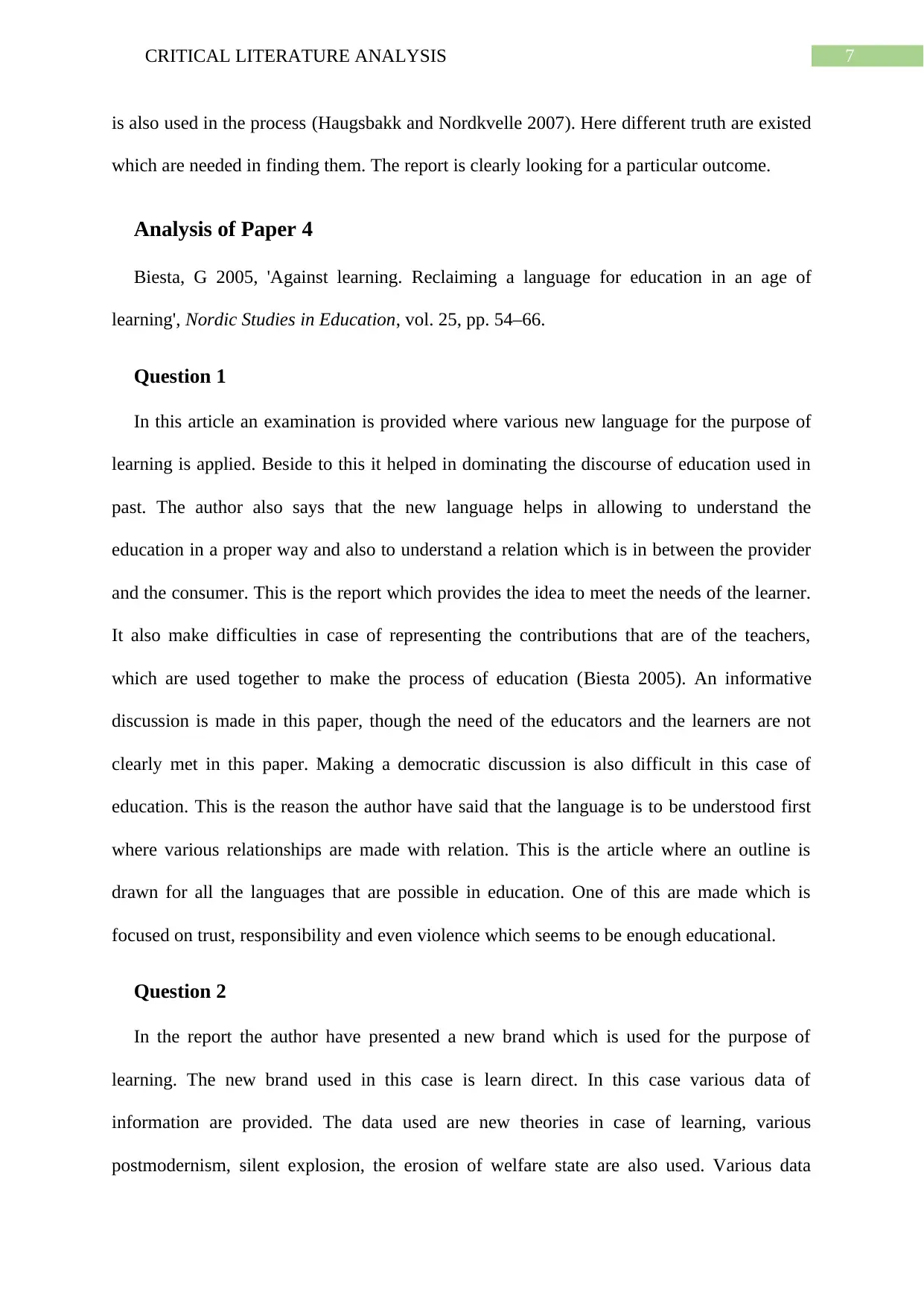
7CRITICAL LITERATURE ANALYSIS
is also used in the process (Haugsbakk and Nordkvelle 2007). Here different truth are existed
which are needed in finding them. The report is clearly looking for a particular outcome.
Analysis of Paper 4
Biesta, G 2005, 'Against learning. Reclaiming a language for education in an age of
learning', Nordic Studies in Education, vol. 25, pp. 54–66.
Question 1
In this article an examination is provided where various new language for the purpose of
learning is applied. Beside to this it helped in dominating the discourse of education used in
past. The author also says that the new language helps in allowing to understand the
education in a proper way and also to understand a relation which is in between the provider
and the consumer. This is the report which provides the idea to meet the needs of the learner.
It also make difficulties in case of representing the contributions that are of the teachers,
which are used together to make the process of education (Biesta 2005). An informative
discussion is made in this paper, though the need of the educators and the learners are not
clearly met in this paper. Making a democratic discussion is also difficult in this case of
education. This is the reason the author have said that the language is to be understood first
where various relationships are made with relation. This is the article where an outline is
drawn for all the languages that are possible in education. One of this are made which is
focused on trust, responsibility and even violence which seems to be enough educational.
Question 2
In the report the author have presented a new brand which is used for the purpose of
learning. The new brand used in this case is learn direct. In this case various data of
information are provided. The data used are new theories in case of learning, various
postmodernism, silent explosion, the erosion of welfare state are also used. Various data
is also used in the process (Haugsbakk and Nordkvelle 2007). Here different truth are existed
which are needed in finding them. The report is clearly looking for a particular outcome.
Analysis of Paper 4
Biesta, G 2005, 'Against learning. Reclaiming a language for education in an age of
learning', Nordic Studies in Education, vol. 25, pp. 54–66.
Question 1
In this article an examination is provided where various new language for the purpose of
learning is applied. Beside to this it helped in dominating the discourse of education used in
past. The author also says that the new language helps in allowing to understand the
education in a proper way and also to understand a relation which is in between the provider
and the consumer. This is the report which provides the idea to meet the needs of the learner.
It also make difficulties in case of representing the contributions that are of the teachers,
which are used together to make the process of education (Biesta 2005). An informative
discussion is made in this paper, though the need of the educators and the learners are not
clearly met in this paper. Making a democratic discussion is also difficult in this case of
education. This is the reason the author have said that the language is to be understood first
where various relationships are made with relation. This is the article where an outline is
drawn for all the languages that are possible in education. One of this are made which is
focused on trust, responsibility and even violence which seems to be enough educational.
Question 2
In the report the author have presented a new brand which is used for the purpose of
learning. The new brand used in this case is learn direct. In this case various data of
information are provided. The data used are new theories in case of learning, various
postmodernism, silent explosion, the erosion of welfare state are also used. Various data
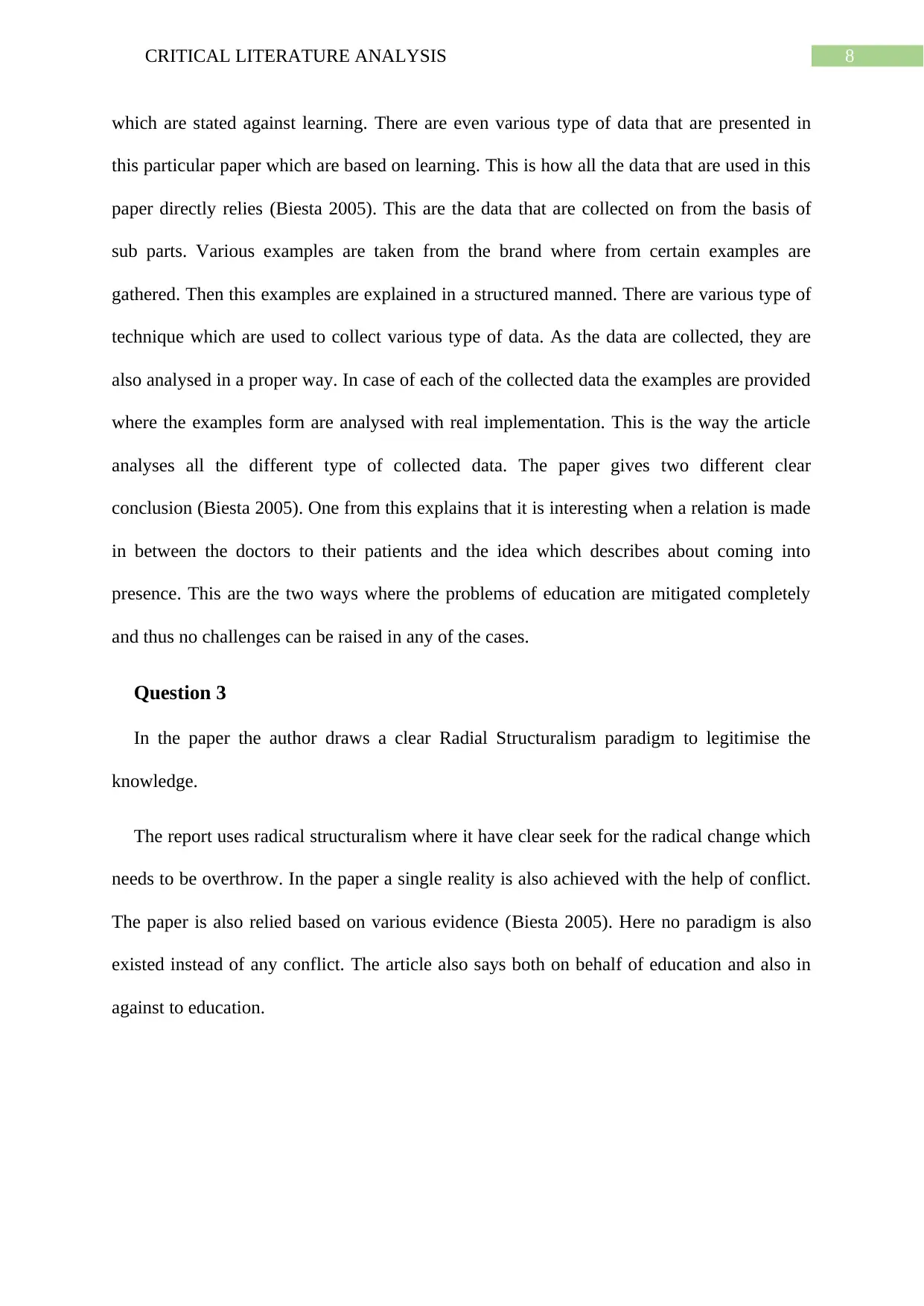
8CRITICAL LITERATURE ANALYSIS
which are stated against learning. There are even various type of data that are presented in
this particular paper which are based on learning. This is how all the data that are used in this
paper directly relies (Biesta 2005). This are the data that are collected on from the basis of
sub parts. Various examples are taken from the brand where from certain examples are
gathered. Then this examples are explained in a structured manned. There are various type of
technique which are used to collect various type of data. As the data are collected, they are
also analysed in a proper way. In case of each of the collected data the examples are provided
where the examples form are analysed with real implementation. This is the way the article
analyses all the different type of collected data. The paper gives two different clear
conclusion (Biesta 2005). One from this explains that it is interesting when a relation is made
in between the doctors to their patients and the idea which describes about coming into
presence. This are the two ways where the problems of education are mitigated completely
and thus no challenges can be raised in any of the cases.
Question 3
In the paper the author draws a clear Radial Structuralism paradigm to legitimise the
knowledge.
The report uses radical structuralism where it have clear seek for the radical change which
needs to be overthrow. In the paper a single reality is also achieved with the help of conflict.
The paper is also relied based on various evidence (Biesta 2005). Here no paradigm is also
existed instead of any conflict. The article also says both on behalf of education and also in
against to education.
which are stated against learning. There are even various type of data that are presented in
this particular paper which are based on learning. This is how all the data that are used in this
paper directly relies (Biesta 2005). This are the data that are collected on from the basis of
sub parts. Various examples are taken from the brand where from certain examples are
gathered. Then this examples are explained in a structured manned. There are various type of
technique which are used to collect various type of data. As the data are collected, they are
also analysed in a proper way. In case of each of the collected data the examples are provided
where the examples form are analysed with real implementation. This is the way the article
analyses all the different type of collected data. The paper gives two different clear
conclusion (Biesta 2005). One from this explains that it is interesting when a relation is made
in between the doctors to their patients and the idea which describes about coming into
presence. This are the two ways where the problems of education are mitigated completely
and thus no challenges can be raised in any of the cases.
Question 3
In the paper the author draws a clear Radial Structuralism paradigm to legitimise the
knowledge.
The report uses radical structuralism where it have clear seek for the radical change which
needs to be overthrow. In the paper a single reality is also achieved with the help of conflict.
The paper is also relied based on various evidence (Biesta 2005). Here no paradigm is also
existed instead of any conflict. The article also says both on behalf of education and also in
against to education.
⊘ This is a preview!⊘
Do you want full access?
Subscribe today to unlock all pages.

Trusted by 1+ million students worldwide
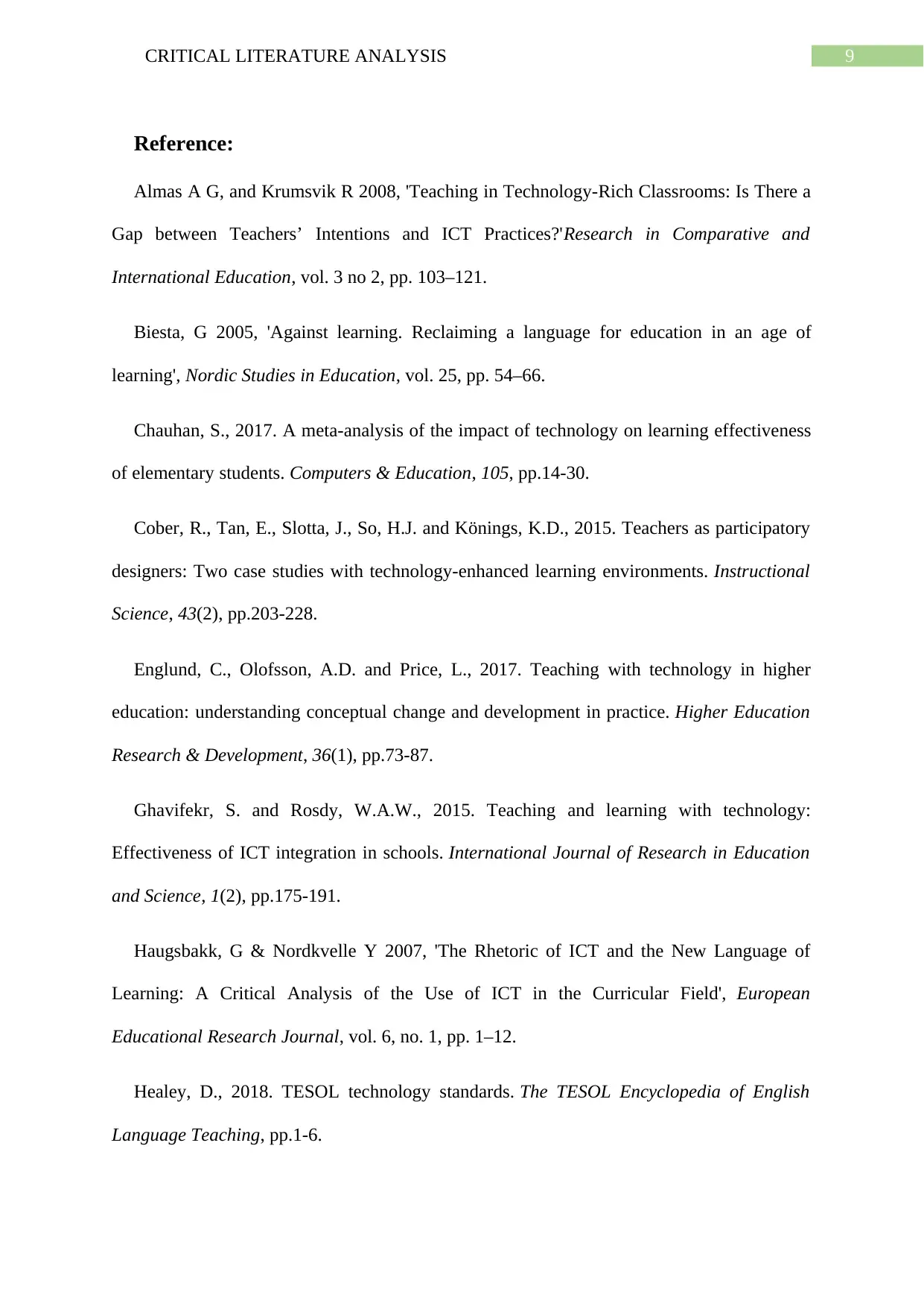
9CRITICAL LITERATURE ANALYSIS
Reference:
Almas A G, and Krumsvik R 2008, 'Teaching in Technology-Rich Classrooms: Is There a
Gap between Teachers’ Intentions and ICT Practices?'Research in Comparative and
International Education, vol. 3 no 2, pp. 103–121.
Biesta, G 2005, 'Against learning. Reclaiming a language for education in an age of
learning', Nordic Studies in Education, vol. 25, pp. 54–66.
Chauhan, S., 2017. A meta-analysis of the impact of technology on learning effectiveness
of elementary students. Computers & Education, 105, pp.14-30.
Cober, R., Tan, E., Slotta, J., So, H.J. and Könings, K.D., 2015. Teachers as participatory
designers: Two case studies with technology-enhanced learning environments. Instructional
Science, 43(2), pp.203-228.
Englund, C., Olofsson, A.D. and Price, L., 2017. Teaching with technology in higher
education: understanding conceptual change and development in practice. Higher Education
Research & Development, 36(1), pp.73-87.
Ghavifekr, S. and Rosdy, W.A.W., 2015. Teaching and learning with technology:
Effectiveness of ICT integration in schools. International Journal of Research in Education
and Science, 1(2), pp.175-191.
Haugsbakk, G & Nordkvelle Y 2007, 'The Rhetoric of ICT and the New Language of
Learning: A Critical Analysis of the Use of ICT in the Curricular Field', European
Educational Research Journal, vol. 6, no. 1, pp. 1–12.
Healey, D., 2018. TESOL technology standards. The TESOL Encyclopedia of English
Language Teaching, pp.1-6.
Reference:
Almas A G, and Krumsvik R 2008, 'Teaching in Technology-Rich Classrooms: Is There a
Gap between Teachers’ Intentions and ICT Practices?'Research in Comparative and
International Education, vol. 3 no 2, pp. 103–121.
Biesta, G 2005, 'Against learning. Reclaiming a language for education in an age of
learning', Nordic Studies in Education, vol. 25, pp. 54–66.
Chauhan, S., 2017. A meta-analysis of the impact of technology on learning effectiveness
of elementary students. Computers & Education, 105, pp.14-30.
Cober, R., Tan, E., Slotta, J., So, H.J. and Könings, K.D., 2015. Teachers as participatory
designers: Two case studies with technology-enhanced learning environments. Instructional
Science, 43(2), pp.203-228.
Englund, C., Olofsson, A.D. and Price, L., 2017. Teaching with technology in higher
education: understanding conceptual change and development in practice. Higher Education
Research & Development, 36(1), pp.73-87.
Ghavifekr, S. and Rosdy, W.A.W., 2015. Teaching and learning with technology:
Effectiveness of ICT integration in schools. International Journal of Research in Education
and Science, 1(2), pp.175-191.
Haugsbakk, G & Nordkvelle Y 2007, 'The Rhetoric of ICT and the New Language of
Learning: A Critical Analysis of the Use of ICT in the Curricular Field', European
Educational Research Journal, vol. 6, no. 1, pp. 1–12.
Healey, D., 2018. TESOL technology standards. The TESOL Encyclopedia of English
Language Teaching, pp.1-6.
Paraphrase This Document
Need a fresh take? Get an instant paraphrase of this document with our AI Paraphraser

10CRITICAL LITERATURE ANALYSIS
Henderson, M., Selwyn, N. and Aston, R., 2017. What works and why? Student
perceptions of ‘useful’digital technology in university teaching and learning. Studies in
Higher Education, 42(8), pp.1567-1579.
Henrie, C.R., Halverson, L.R. and Graham, C.R., 2015. Measuring student engagement in
technology-mediated learning: A review. Computers & Education, 90, pp.36-53.
Howard, SK, Thompson K, Yang, J & Ma, J 2017, 'Working the system: Development of
a system model of technology integration to inform learning task design', British Journal of
Educational Technology, vol. 50, no. 1, pp. 326–341.
Irwansyah, F.S., Yusuf, Y.M., Farida, I. and Ramdhani, M.A., 2018, January. Augmented
reality (AR) technology on the android operating system in chemistry learning. In IOP
conference series: Materials science and engineering (Vol. 288, No. 1, p. 012068). IOP
Publishing.
Kali, Y., McKenney, S. and Sagy, O., 2015. Teachers as designers of technology enhanced
learning. Instructional science, 43(2), pp.173-179.
Ng'ambi, D., Brown, C., Bozalek, V., Gachago, D. and Wood, D., 2016. Technology
enhanced teaching and learning in South African higher education–A rearview of a 20 year
journey. British Journal of Educational Technology, 47(5), pp.843-858.
Skinner, B.F., 2016. The technology of teaching. BF Skinner Foundation.
Teo, T. and Milutinovic, V., 2015. Modelling the intention to use technology for teaching
mathematics among pre-service teachers in Serbia. Australasian Journal of Educational
Technology, 31(4).
Henderson, M., Selwyn, N. and Aston, R., 2017. What works and why? Student
perceptions of ‘useful’digital technology in university teaching and learning. Studies in
Higher Education, 42(8), pp.1567-1579.
Henrie, C.R., Halverson, L.R. and Graham, C.R., 2015. Measuring student engagement in
technology-mediated learning: A review. Computers & Education, 90, pp.36-53.
Howard, SK, Thompson K, Yang, J & Ma, J 2017, 'Working the system: Development of
a system model of technology integration to inform learning task design', British Journal of
Educational Technology, vol. 50, no. 1, pp. 326–341.
Irwansyah, F.S., Yusuf, Y.M., Farida, I. and Ramdhani, M.A., 2018, January. Augmented
reality (AR) technology on the android operating system in chemistry learning. In IOP
conference series: Materials science and engineering (Vol. 288, No. 1, p. 012068). IOP
Publishing.
Kali, Y., McKenney, S. and Sagy, O., 2015. Teachers as designers of technology enhanced
learning. Instructional science, 43(2), pp.173-179.
Ng'ambi, D., Brown, C., Bozalek, V., Gachago, D. and Wood, D., 2016. Technology
enhanced teaching and learning in South African higher education–A rearview of a 20 year
journey. British Journal of Educational Technology, 47(5), pp.843-858.
Skinner, B.F., 2016. The technology of teaching. BF Skinner Foundation.
Teo, T. and Milutinovic, V., 2015. Modelling the intention to use technology for teaching
mathematics among pre-service teachers in Serbia. Australasian Journal of Educational
Technology, 31(4).
1 out of 11
Related Documents
Your All-in-One AI-Powered Toolkit for Academic Success.
+13062052269
info@desklib.com
Available 24*7 on WhatsApp / Email
![[object Object]](/_next/static/media/star-bottom.7253800d.svg)
Unlock your academic potential
Copyright © 2020–2025 A2Z Services. All Rights Reserved. Developed and managed by ZUCOL.





